Kwala: 2D Animator
As a 2D Animator, my responsibilities focused on creating animations that met both technical and creative standards. The project incorporated both 3D scenes and 2D characters, requiring me to work with software such as Procreate and Adobe After Effects. Throughout the project, I maintained open communication with the team, incorporating feedback from teams and producer to enhance the animation quality. My work helped ensure the animation was smoothly integrated into the project, adding depth and elevating the overall viewer experience.
Production Process
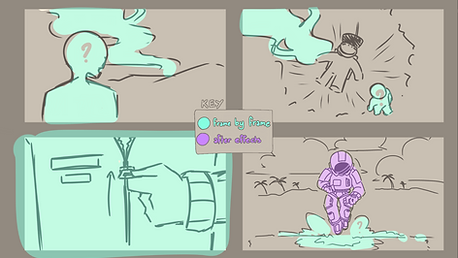

This is the storyboard for the segment "Solemn Hero," for which I am responsible. It provides an overview of event timing, pacing, and transitions between scenes, offering a rough estimate of how long each part of the story will take.

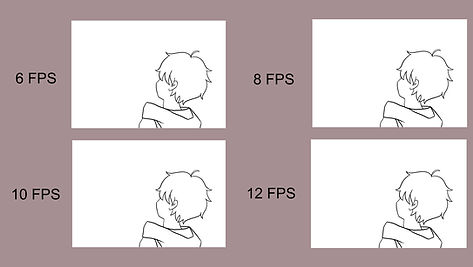
Before the official production of the animation, I had to create a frame rate test. Based on the two looped animations selected during team discussions, I created tests with different frame rates. I tested them myself at 4FPS, 8FPS, 12FPS, and 16FPS. I found that 4FPS was too slow and choppy, making the motion look stilted, while 16FPS was too fast, causing the actions to flash by too quickly for the audience to fully perceive. As a result, I focused on testing frame rates between 6FPS and 12FPS, exporting these tests and sharing them with the team for feedback. The team ultimately chose 6FPS, as they felt this frame rate best conveyed the essence of the looped animation while still appearing smooth enough. In terms of style, the team preferred the second option because it had a more animated feel. After further team discussions, we decided to set the base frame rate at 6FPS, with the option to increase it to 8FPS for specific scenes that required smoother motion. Additionally, we decided to use both animation styles: the first style for Jerral, and the second style for elements like smoke and meteors. This allowed the scene to maintain an animated feel while ensuring that not every part of the scene was in motion, which would help to keep the focus on the important elements of the animation.


Animation production began by first drawing the required 2D characters for each scene, with color and lighting confirmed.
Then, they were placed into the scenes, referencing the timing and positioning from the storyboard. This step is essential for characters are aligned with the story's timing, positioning, and intended movements.

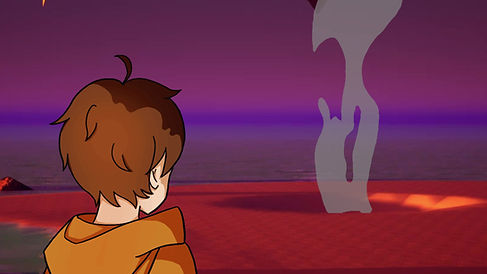
Through continuous improvement and optimization, the process gradually approaches the final goal. Each iteration involves adjusting and refining the project based on feedback, test results, and new requirements.
This iteration adjusted the character lighting and shadow as well as scene camera movement. Refining lighting and shadows adds depth to characters, making them appear more three-dimensional and realistic within the scene. Camera movement adjustments create smoother transitions, making the animation flow better and improving the viewing experience. This iteration allows for improved composition, balancing elements within the frame and ensuring that each scene is visually cohesive.
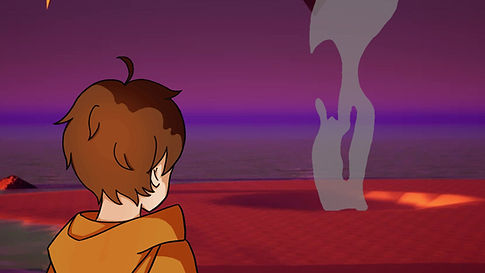
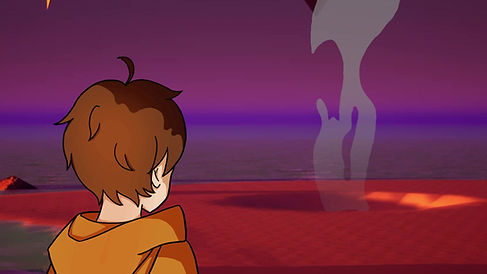
This iteration added transition scenes, adjusted some camera angles, and included extra details like blinking lights on the spacesuit. The transition scenes were created to establish a connection with the previous animation segment, Ocean Breeze, ensure continuity, helping viewers intuitively follow the story across different scenes. Small details, such as the spacesuit’s blinking lights, add realism and depth, enhancing the immersive quality of the scene. These refinements contribute to a polished, professional look, elevating the overall quality of the animation.
The final iteration improved the opacity of the smoke and added a new pose for the character’s flight. Adjusting smoke opacity adds depth and realism, making the environment feel more three-dimensional and immersive. The new flight pose and fluctuating movement with the flames make the character’s actions appear more natural and realistic, matching the physical logic of propulsion. The character’s responsive movement with the flames provides a better sense of momentum and energy, making the flight feel more alive and interactive.
Challenges and Solutions
The Kwala project presented unique challenges in integrating 2D animated characters with a fully realized 3D background. Creating a cohesive visual style across these dimensions was complex, particularly with respect to color and lighting compatibility. The dynamic lighting in the 3D environment often altered how the 2D characters appeared, resulting in inconsistencies that could detract from the viewing experience and compromise visual clarity.
To overcome this, I conducted extensive testing to identify a color palette that harmonized with the lighting conditions of the 3D environment while ensuring the characters remained distinct and visually appealing. I explored various color schemes, making continual adjustments to keep the characters aligned with the background lighting. Frequent feedback from team members and supervisors was invaluable in this iterative process; through consistent color and contrast refinements, I achieved a visual style in which the 2D characters integrated naturally with the 3D setting, enhancing overall cohesion.
As the project progressed, certain creative and technical requirements evolved based on discussions with the team and feedback from the music producers. Adapting to these evolving needs while staying on schedule was challenging, requiring both creative flexibility and technical agility.
To manage these changes effectively, I maintained open communication with team members and music producers, scheduling regular check-ins to ensure alignment on any updates. I adapted quickly to feedback, modifying character designs and adjusting animation sequences as needed. This proactive approach allowed me to implement necessary changes efficiently, ensuring that the animation remained consistent with the project’s artistic direction and the musical narrative, without compromising the project timeline.
Result
The 2D animation successfully aligned with the musical rhythm and storyline of the Kwala project, enhancing the viewer’s experience by visually supporting the narrative. This project taught me the importance of adjusting animation style to match musical elements, enabling me to bring out the emotional depth of the visuals. This project taught me to effectively incorporate timing and pacing into my animations, and it strengthened my ability to create animations that resonate with the accompanying music, deepening the viewer’s engagement. This experience enhanced my flexibility and collaboration skills, reinforcing my ability to produce animations that are both technically precise and creatively impactful.